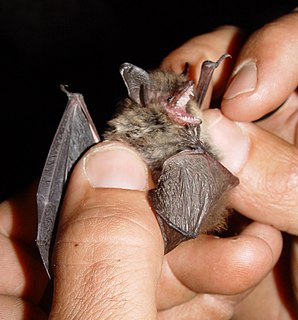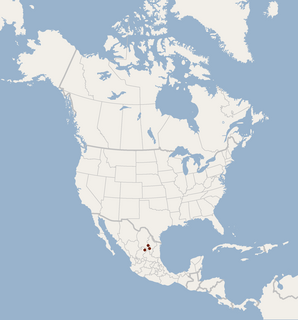
Natterer's bat is a European vespertilionid bat with pale wings. It has brown fur tending to greyish-white on its underside. It is found across most of the continent of Europe, parts of the Near East and North Africa. It feeds on insects and other invertebrates which it catches on the wing or pursues on the ground.

The mouse-eared bats are a diverse and widespread genus (Myotis) of bats within the family Vespertilionidae.

The Alpine long-eared bat or mountain long-eared bat is a species of long-eared bat. It was originally described from Switzerland and Austria as a species intermediate between the brown long-eared bat and the grey long-eared bat in 1965. It was later described in 2002, from France and Austria, respectively. Despite its name, this species is not restricted to the Alps, being found in Croatia, Bosnia and Herzegovina and elsewhere. It differs from other European long-eared bats, such as the brown long-eared bat, by its white underparts.

Brandt's bat is a species of vesper bat in the family Vespertilionidae. It is native throughout most of Europe and parts of Asia. It is known for its high life expectancy relative to its body size, approximately twice that of humans and holds the record for the oldest bat; in 2005, one individual was discovered in a cave in Siberia that had been banded in 1964, making the bat at least 41 years old.

The eastern small-footed bat is a species of vesper bat. It can be found in southern Ontario and Quebec in Canada and in mountainous portions of the eastern United States from New England to northern Georgia, and westward to northern Arkansas. It is among the smallest bats in eastern North America and is known for its small feet and black face-mask. Until recently, all North American small-footed Myotis were considered to be "Myotis leibii". The western population is now considered to be a separate species, Myotis ciliolabrum. The Eastern small-footed bat is rare throughout its range, although the species may be locally abundant where suitable habitat exists. Studies suggest white-nose syndrome has caused declines in their populations. However, most occurrences of this species have only been counted within the past decade or two and are not revisited regularly, making their population status difficult to assess. Additionally, most bat populations in the Eastern U.S. have been monitored using surveys conducted in caves and mines in the winter, but Eastern small-footed bats hibernate in places that make them unlikely to be encountered during these surveys. Perhaps as a result, the numbers of Eastern small-footed bats counted in winter tend to be low and they are relatively variable compared to other species of bats. Many biologists believe the species is stable, having declined little in recent times, but that it is vulnerable due to its relatively restricted geographic range and habitat needs.

The flat-headed myotis is a species of vesper bat. It is endemic to Mexico where it is found in certain montane forests in the Sierra Madre Oriental in the northeast of the country. Once thought to be extinct, this bat was rediscovered in 2004 by Joaquín Arroyo-Cabrales and colleagues. The species is now classified as endangered by the IUCN.

The frosted myotis is a species of vesper bat. It is found only in Japan.
Schaub's myotis is a species of vesper bat. It is found in Armenia, Azerbaijan and Iran and known from fossils from Hungary. It is related to Myotis nattereri.
Myotinae is a subfamily of vesper bats. Submyotodon is the second extant genus included in the subfamily Myotinae. Before the description of Submyotodon and analysis of its phylogenetics, the only member of Myotinae was the genus Myotis.

The little brown bat or little brown myotis is a species of mouse-eared microbat found in North America. It has a small body size and glossy brown fur. It is similar in appearance to several other mouse-eared bats, including the Indiana bat, northern long-eared bat, and Arizona myotis, to which it is closely related. Despite its name, the little brown bat is not closely related to the big brown bat, which belongs to a different genus.

The Alcathoe bat is a European bat in the genus Myotis. Known only from Greece and Hungary when it was first described in 2001, its known distribution has since expanded to Spain, England, Sweden, and Azerbaijan, among other countries. It is similar to the whiskered bat and other species and is difficult to distinguish from them. However, its brown fur is distinctive and it is clearly different in characters of its karyotype and DNA sequences. Although some genetic data suggest that it is related to Geoffroy's bat, other analyses do not support a close relationship between M. alcathoe and any other species.

Escalera's bat is a European bat in the genus Myotis, found in Spain, Portugal, and far southern France.

Old Bow And Old Ham Mines is a 40.3-hectare (100-acre) biological Site of Special Scientific Interest in Gloucestershire, notified in 1998.

The cryptic myotis is a European vespertilionid bat. It is a member of the Natterer's bat species complex, and is also the closest living relative of M. nattereri. It is mostly distributed across European countries bordering the Mediterranean Sea, from Spain west to Austria, north to Switzerland, and south to most of the Italian Peninsula. Populations of similar bats in southern Italy and Sicily display significant genetic divergence from M. crypticus, and thus may represent a unique taxonomic entity that requires more study. It is found in a wide range of altitudes, from sea level to 1000 meters above. It feeds in forest and grassland habitats and roosts in tree hollows as well as man-made structures. In autumn, M. crypticus swarms with other Myotis in large numbers, and overwinters with them in underground sites such as crevices.
Miniopterus maghrebensis, also known as the Maghrebian bent-wing bat, is a species of bat found in North Africa.











